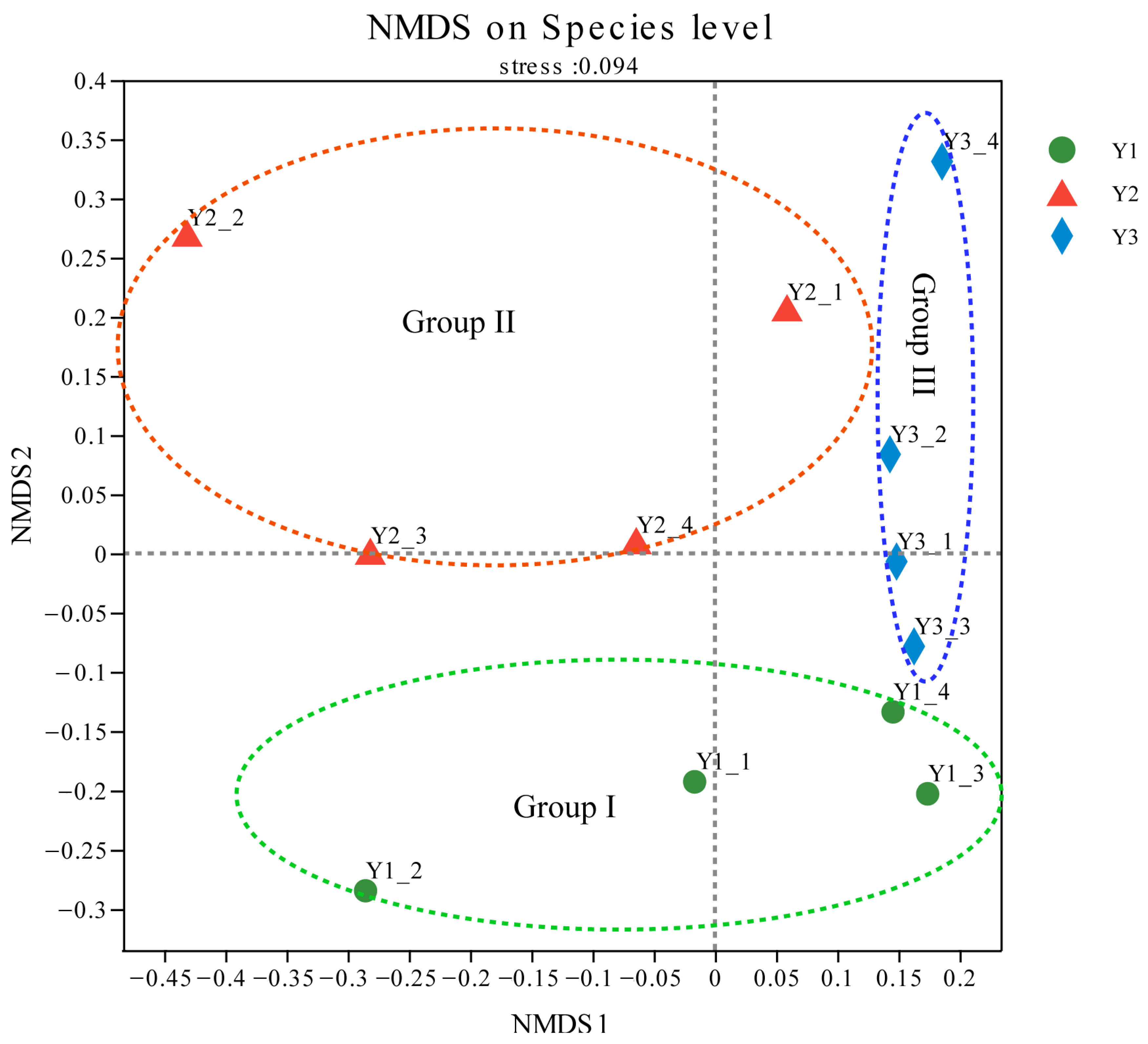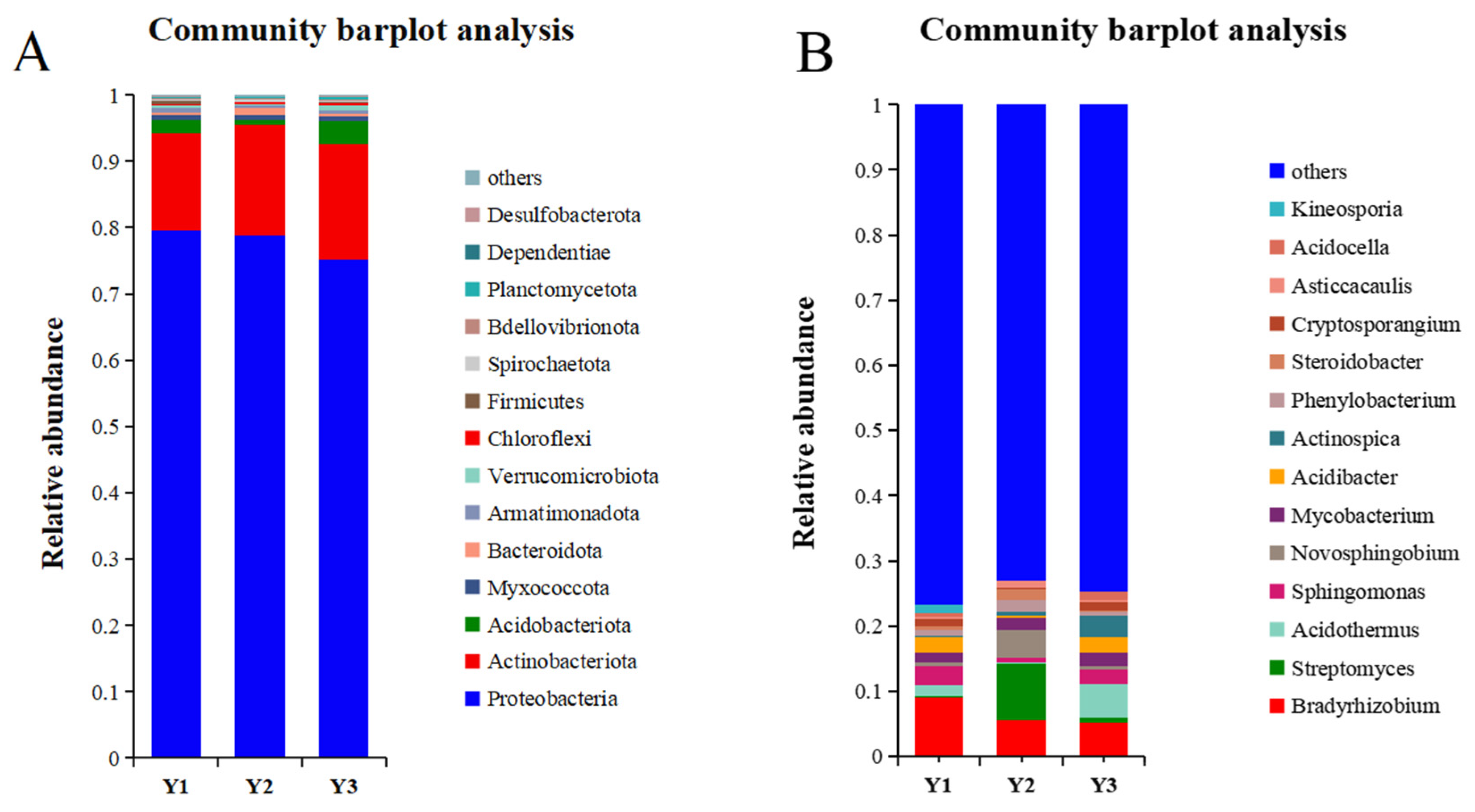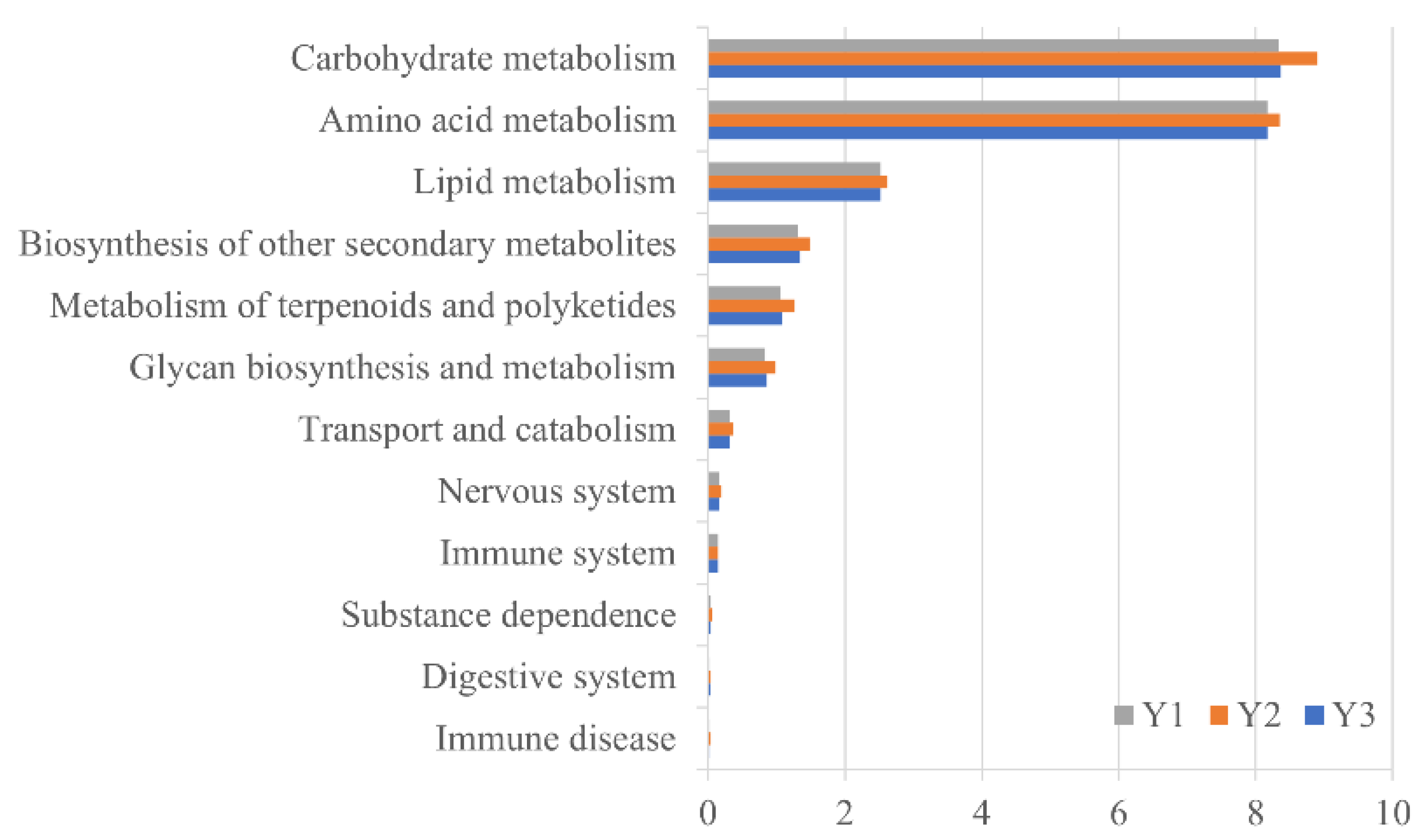Differences in Root Endophytic Bacterial Communities of Chinese Cork Oak (Quercus variabilis) Seedlings in Different Growth Years
Abstract
1. Introduction
2. Materials and Methods
2.1. Study Area and Sample Collection
2.2. Soil Physicochemical Properties
2.3. DNA Extraction and PCR Amplification
2.4. Bioinformatics and Statistical Analysis
3. Results
3.1. Physicochemical Properties
3.2. Alpha Diversity
3.3. Beta Diversity
3.4. Environmental Factors Influencing Bacterial Community Structure
3.5. Bacterial Community Structure
3.6. Function Analysis
4. Discussion
4.1. Effects of Seedling Age
4.2. Changes Favorable to Seedlings
4.3. Changes Harmful to the Q. variabilis Seedlings
4.4. Bacterial Community Responses to Environmental Conditions
4.5. Effects of Age on Bacterial Community Function
5. Conclusions
Supplementary Materials
Author Contributions
Funding
Data Availability Statement
Conflicts of Interest
References
- Chen, D.; Zhang, X.; Kang, H.; Sun, X.; Yin, S.; Du, H.; Yamanaka, N.; Gapare, W.; Wu, H.X.; Liu, C. Phylogeography of Quercus variabilis based on chloroplast DNA sequence in East Asia: Multiple glacial refugia and Mainland-migrated island populations. PLoS ONE 2012, 7, e47268. [Google Scholar] [CrossRef] [PubMed]
- Gao, W.; Liu, J.; Xue, Z.; Zhang, Y.; Gao, Z.; Ni, Y.; Wang, X.; Jiang, Z. Geographical patterns and drivers of growth dynamics of Quercus variabilis. Forest Ecol. Manag. 2018, 429, 256–266. [Google Scholar] [CrossRef]
- Wang, R.; Lv, F.; Lv, R.; Lin, H.; Zhang, Z.; Wei, L. Sampling period and disease severity of bacterial wilt significantly affected the bacterial community structure and functional prediction in the sesame rhizosphere soil. Rhizosphere 2023, 26, 100704. [Google Scholar] [CrossRef]
- Lei, D.; Zhang, W.; Guan, J. Seed rain and community diversity of Liaotung oak (Quercus liaotungensis Koidz) in Shaanxi, northwest China. Ecol. Eng. 2014, 67, 104–111. [Google Scholar] [CrossRef]
- Zhang, J.; Yan, X.; Dayananda, B.; Luo, Y.; Li, J. Frequency-dependent predation and seedling fate: Effect of forest litter on regeneration of the Quercus wutaishanica seedling. Global Ecol. Conserv. 2022, 38, e02233. [Google Scholar] [CrossRef]
- Li, Q.; Xiao, Z.; Ren, M.; Han, F.; Hu, K. Variation of bacterial bommunity structure in Gardenia jas minoides rhizosphere at different growth stages. J. Soil Sci. 2021, 52, 346–354. [Google Scholar] [CrossRef]
- Badano, E.I.; Sánchez-Montes de Oca, E.J. Seed fate, seedling establishment and the role of propagule size in forest regeneration under climate change conditions. Forest Ecol. Manag. 2022, 503, 119776. [Google Scholar] [CrossRef]
- Beals, K.; Scearce, A.; Swystun, A.; Schweitzer, J. Belowground mechanisms for oak regeneration: Interactions among fire, soil microbes; plant community alter oak seedling growth. Forest Ecol. Manag. 2022, 503, 119774. [Google Scholar] [CrossRef]
- Deniau, M.; Jung, V.; Le Lann, C.; Morra, T.; Murray, P.; Prinzing, A. Janzen-Connell patterns are not the result of Janzen-Connell process: Oak recruitment in temperate forests. Perspect. Plant Ecol. 2017, 24, 72–79. [Google Scholar] [CrossRef]
- Qin, J.; Zhang, C.; Zhao, X. Testing Janzen-Connell hypothesis based on plant-soil feedbacks in a temperate coniferous and broadleaved mixed forest. Chin. J. Plant Ecol. 2022, 46, 624–631. [Google Scholar] [CrossRef]
- Comita, L.S.; Muller-Landau, H.C.; Aguilar, S.; Hubbell, S.P. Asymmetric density dependence shapes species abundances in a tropical tree community. Science 2010, 329, 330–332. [Google Scholar] [CrossRef]
- Cui, X.; Meng, T.; Zhu, N.; Li, X.; Leng, F.; Wang, Y. Composition, function and driving factors of microbial communities in rhizosphere soil and root endophyte of Codonopsis pilosula in different years. Rhizosphere 2023, 27, 100712. [Google Scholar] [CrossRef]
- Andrade, G.V.S.; Rodrigues, F.A.; Nadal, M.C.; da Silva Dambroz, C.M.; Martins, A.D.; Rodrigues, V.A.; dos Reis Ferreira, G.M.; Pasqual, M.; Buttros, V.H.; Dória, J. Plant-endophytic bacteria interactions associated with root and leaf microbiomes of Cattleya walkeriana and their effect on plant growth. Sci. Hortic. 2023, 309, 111656. [Google Scholar] [CrossRef]
- Maghnia, F.Z.; Abbas, Y.; Mahé, F.; Prin, Y.; El Ghachtouli, N.; Duponnois, R.; Sanguin, H. The rhizosphere microbiome: A key component of sustainable cork oak forests in trouble. Forest Ecol. Manag. 2019, 434, 29–39. [Google Scholar] [CrossRef]
- Wang, W.; Wang, J.; Meng, J. A climate-sensitive mixed-effects tree recruitment model for oaks (Quercus spp.) in Hunan Province, south-central China. Forest Ecol. Manag. 2023, 528, 120631. [Google Scholar] [CrossRef]
- Kuzyakov, Y.; Razavi, B.S. Rhizosphere size and shape: Temporal dynamics and spatial stationarity. Soil Biol. Biochem. 2019, 135, 343–360. [Google Scholar] [CrossRef]
- Ogbe, A.A.; Finnie, J.F.; Van Staden, J. The role of endophytes in secondary metabolites accumulation in medicinal plants under abiotic stress. S. Afr. J. Bot. 2020, 134, 126–134. [Google Scholar] [CrossRef]
- Zhao, R.; Zheng, S.; Hu, Y.; Li, H.; Chen, Y.; Chun, Z. Endophytic bacterial diversity of the medicinal orchid Dendrobium nobile. S. Afr. J. Bot. 2023, 158, 90–97. [Google Scholar] [CrossRef]
- Zhang, J.; Liu, Y.X.; Zhang, N.; Hu, B.; Jin, T.; Xu, H.; Qin, Y.; Yan, P.; Zhang, X.; Guo, X.; et al. NRT1.1B is associated with root microbiota composition and nitrogen use in field-grown rice. Nat. Biotechnol. 2019, 37, 676–684. [Google Scholar] [CrossRef]
- Wang, Z.; Wang, H.; Chen, Z.; Wu, Q.; Huang, K.; Ke, Q.; Zhu, L.; Lu, S.; Tang, Y.; Li, H.; et al. Ecological niche differences regulate the assembly of bacterial community in endophytic and rhizosphere of Eucalyptus. For. Ecol. Manag. 2022, 524, 120521. [Google Scholar] [CrossRef]
- Lu, T.; Ke, M.; Lavoie, M.; Jin, Y.; Fan, X.; Zhang, Z.; Fu, Z.; Sun, L.; Gillings, M.; Peñuelas, J. Rhizosphere microorganisms can influence the timing of plant flowering. Microbiome 2018, 6, 231. [Google Scholar] [CrossRef] [PubMed]
- Wu, X.; Wang, J.; Yu, Z.; Amanze, C.; Shen, L.; Wu, X.; Li, J.; Yu, R.; Liu, Y.; Zeng, W. Impact of bamboo sphere amendment on composting performance and microbial community succession in food waste composting. J. Environ. Manag. 2022, 303, 114144. [Google Scholar] [CrossRef] [PubMed]
- He, Y.; Huang, X.; Zhang, H.; Li, H.; Zhang, Y.; Zheng, X.; Xie, L. Insights into the effect of iron-carbon particle amendment on food waste composting: Physicochemical properties and the microbial community. Bioresour. Technol. 2022, 351, 126939. [Google Scholar] [CrossRef] [PubMed]
- Sui, L.; Tang, C.; Cheng, K.; Yang, F. Biochar addition regulates soil phosphorus fractions and improves release of available phosphorus under freezing-thawing cycles. Sci. Total Environ. 2022, 848, 157748. [Google Scholar] [CrossRef]
- Kong, W.; Sun, B.; Zhang, J.; Zhang, Y.; Gu, L.; Bao, L.; Liu, S. Metagenomic analysis revealed the succession of microbiota and metabolic function in corncob composting for preparation of cultivation medium for Pleurotus ostreatus. Bioresour. Technol. 2020, 306, 123156. [Google Scholar] [CrossRef]
- Magoc, T.; Salzberg, S. FLASH: Fast length adjustment of short reads to improve genome assemblies. Bioinformatics 2011, 27, 2957–2963. [Google Scholar] [CrossRef]
- Edgar, R.C. UPARSE: Highly accurate OTU sequences from microbial amplicon reads. Nat. Methods 2013, 10, 996–998. [Google Scholar] [CrossRef]
- Nilsson, R.H.; Larsson, K.H.; Taylor, A.F.S.; Bengtsson-Palme, J.; Jeppesen, T.S.; Schigel, D.; Kennedy, P.; Picard, K.; Glockner, F.O.; Tedersoo, L.; et al. The UNITE database for molecular identification of fungi: Handling dark taxa and parallel taxonomic classifications. Nucleic Acids Res. 2019, 47, D259–D264. [Google Scholar] [CrossRef]
- Sun, C.; Zhang, B.; Chen, Z.; Qin, W.; Wen, X. Sludge retention time affects the microbial community structure: A large-scale sampling of aeration tanks throughout China. Environ. Pollut. 2020, 261, 114140. [Google Scholar] [CrossRef]
- Kanehisa, M.; Goto, S.; Sato, Y.; Furumichi, M.; Tanabe, M. KEGG for integration and interpretation of large-scale molecular data sets. Nucleic Acids Res. 2012, 40, D109–D114. [Google Scholar] [CrossRef]
- König, S.; Vogel, H.-J.; Harms, H.; Worrich, A. Physical, chemical and biological effects on soil bacterial dynamics in microscale models. Front. Ecol. Evol. 2020, 8, 53. [Google Scholar] [CrossRef]
- Liu, S.; Gao, J.; Wang, S.; Li, W.; Wang, A. Community differentiation of rhizosphere microorganisms and their responses to environmental factors at different development stages of medicinal plant Glehnia littoralis. PeerJ 2023, 11, e14988. [Google Scholar] [CrossRef]
- Torsvik, V.; Sørheim, R.; Goksøyr, J. Total bacterial diversity in soil and sediment communities a review. J. Indust. Microbiol. 1996, 17, 170–178. [Google Scholar] [CrossRef]
- Cusack, D.; Silver, W.; Torn, M.; Burton, S.; Firestone, M. Changes in microbial community characteristics and soil organic matter with nitrogen additions in two tropical forests. Ecology 2011, 92, 621–632. [Google Scholar] [CrossRef]
- Gu, Y.; Zhang, X.; Tu, S.; Lindström, K. Soil microbial biomass, crop yields; bacterial community structure as affected by long-term fertilizer treatments under wheat-rice cropping. Eur. J. Soil Biol. 2009, 45, 239–246. [Google Scholar] [CrossRef]
- Wang, C.; Liu, D.; Bai, E. Decreasing soil microbial diversity is associated with decreasing microbial biomass under nitrogen addition. Soil Biol. Biochem. 2018, 120, 126–133. [Google Scholar] [CrossRef]
- Delgado-Baquerizo, M.; Reich, P.B.; Khachane, A.N.; Campbell, C.D.; Thomas, N.; Freitag, T.E.; Abu Al-Soud, W.; Sorensen, S.; Bardgett, R.D.; Singh, B. It is elemental: Soil nutrient stoichiometry drives bacterial diversity. Environ. Microbiol. 2017, 19, 1176–1188. [Google Scholar] [CrossRef]
- Xiao, Z.; Han, R.; Su, J.; Zhu, Z.; Zhao, Y.; Chen, Q.; Zhao, J.; Li, G.; Zhu, Y. Application of earthworm and silicon can alleviate antibiotic resistance in soil-Chinese cabbage system with ARGs contamination. Environ. Pollut. 2023, 319, 120900. [Google Scholar] [CrossRef]
- Yadav, A.; Kour, D.; Devi, R.; Yadav, A.; Dikilitas, M.; Abdel-Azeem, A.M.; Ahluwalia, A.; Saxena, A. Biodiversity; biotechnological contribution of beneficial soil microbiomes for nutrient cycling, plant growth improvement and nutrient uptake. Biocatal. Agricul. Biotechnol. 2021, 33, 102009. [Google Scholar] [CrossRef]
- Senate, L.M.; Tjatji, M.P.; Pillay, K.; Chen, W.; Zondo, N.M.; Syed, P.R.; Mnguni, F.C.; Chiliza, Z.E.; Bamal, H.D.; Karpoormath, R.; et al. Similarities, variations; evolution of cytochrome P450s in Streptomyces versus Mycobacterium. Sci. Rep. 2019, 9, 3962. [Google Scholar] [CrossRef]
- Chang, F.; Jia, F.; Lv, R.; Guan, M.; Jia, Q.; Sun, Y.; Li, Z. Effects of american ginseng cultivation on bacterial community structure and responses of soil nutrients in different ecological niches. J. Microbiol. Biotechnol. 2022, 32, 419–429. [Google Scholar] [CrossRef] [PubMed]
- Martins, J.; Ares, A.; Costa, J.; Canhoto, J. A baseline of Arbutus unedo L. microbiome for future research: In vitro versus ex vitro. Sci. Horticul. 2022, 292, 110657. [Google Scholar] [CrossRef]
- Wang, H.; Guo, Q.; Li, X.; Li, X.; Yu, Z.; Li, X.; Yang, T.; Su, Z.; Zhang, H.; Zhang, C. Effects of long-term no-tillage with different straw mulching frequencies on soil microbial community and the abundances of two soil-borne pathogens. Appl. Soil Ecol. 2020, 148, 103488. [Google Scholar] [CrossRef]
- Xiong, W.; Li, Z.; Liu, H.; Xue, C.; Zhang, R.; Wu, H.; Li, R.; Shen, Q. The effect of long-term continuous cropping of black pepper on soil bacterial communities as determined by 454 Pyrosequencing. PLoS ONE 2015, 10, e0136946. [Google Scholar] [CrossRef]
- Zhang, L.; Xu, Z. Assessing bacterial diversity in soil. J. Soils Sedi. 2008, 8, 379–388. [Google Scholar] [CrossRef]
- Yarwood, S.; Myrold, D.; Hogberg, M. Termination of belowground C allocation by trees alters soil fungal and bacterial communities in a boreal forest. FEMS Microbiol. Ecol. 2009, 70, 151–162. [Google Scholar] [CrossRef]
- Zhao, J.; Zhang, D.; Yang, Y.; Pan, Y.; Zhao, D.; Zhu, J.; Zhang, L.; Yang, Z. Dissecting the effect of continuous cropping of potato on soil bacterial communities as revealed by high-throughput sequencing. PLoS ONE 2020, 15, e0233356. [Google Scholar] [CrossRef]
- Kim, H.-S.; Lee, S.-H.; Jo, H.Y.; Finneran, K.T.; Kwon, M.J. Diversity and composition of soil Acidobacteria and Proteobacteria communities as a bacterial indicator of past land-use change from forest to farmland. Sci. Total Environ. 2021, 797, 148944. [Google Scholar] [CrossRef]
- Hogberg, M.N.; Hogberg, P.; Myrold, D.D. Is microbial community composition in boreal forest soils determined by pH, C-to-N ratio, the trees, or all three? Oecologia 2007, 150, 590–601. [Google Scholar] [CrossRef]
- Ma, X.; Zhou, Z.; Chen, J.; Xu, H.; Ma, S.; Dippold, M.A.; Kuzyakov, Y. Long-term nitrogen and phosphorus fertilization reveals that phosphorus limitation shapes the microbial community composition and functions in tropical montane forest soil. Sci. Total Environ. 2022, 854, 158709. [Google Scholar] [CrossRef]
- Huang, J.; Hu, B.; Qi, K.; Chen, W.; Pang, X.; Bao, W.; Tian, G. Effects of phosphorus addition on soil microbial biomass and community composition in a subalpine spruce plantation. Eur. J. Soil Biol. 2016, 72, 35–41. [Google Scholar] [CrossRef]
- Yang, X.; Cheng, J.; Franks, A.; Huang, X.; Yang, Q.; Cheng, Z.; Liu, Y.; Ma, B.; Xu, J.; He, Y. Loss of microbial diversity weakens specific soil functions, but increases soil ecosystem stability. Soil Biol. Biochem. 2023, 177, 108916. [Google Scholar] [CrossRef]
- Bell, T.H.; Yergeau, E.; Maynard, C.; Juck, D.; Whyte, L.G.; Greer, C.W. Predictable bacterial composition and hydrocarbon degradation in Arctic soils following diesel and nutrient disturbance. ISME J. 2013, 7, 1200–1210. [Google Scholar] [CrossRef]
- Siles, J.A.; Margesin, R. Seasonal soil microbial responses are limited to changes in functionality at two Alpine forest sites differing in altitude and vegetation. Sci. Rep. 2017, 7, 2204. [Google Scholar] [CrossRef]
- Zhu, P.; Yang, S.; Wu, Y.; Ru, Y.; Yu, X.; Wang, L.; Guo, W. Shifts in soil microbial community composition, function; cooccurrence network of phragmites australis in the Yellow River delta. Front. Microbiol. 2022, 13, 858125. [Google Scholar] [CrossRef]
- Ran, T.; Li, J.; Liao, H.; Zhao, Y.; Yang, G.; Long, J. Effects of biochar amendment on bacterial communities and their function predictions in a microplastic-contaminated Capsicum annuum L. soil. Environ. Tech. Innova. 2023, 31, 103174. [Google Scholar] [CrossRef]





| Y1 | Y2 | Y3 | |
|---|---|---|---|
| pH | 5.810 ± 0.334 b | 5.547 ± 0.050 ab | 5.458 ± 0.041 a |
| TP | 0.029 ± 0.005 b | 0.027 ± 0.001 b | 0.016 ± 0.001 a |
| NH4+-N | 0.008 ± 0.001 a | 0.014 ± 0.005 b | 0.010 ± 0.001 ab |
| TOC | 4.997 ± 0.476 a | 7.725 ± 0.617 c | 6.379 ± 0.418 ab |
| NO3−-N | 0.625 ± 0.056 a | 1.619 ± 0.056 c | 1.052 ± 0.303 b |
Disclaimer/Publisher’s Note: The statements, opinions and data contained in all publications are solely those of the individual author(s) and contributor(s) and not of MDPI and/or the editor(s). MDPI and/or the editor(s) disclaim responsibility for any injury to people or property resulting from any ideas, methods, instructions or products referred to in the content. |
© 2023 by the authors. Licensee MDPI, Basel, Switzerland. This article is an open access article distributed under the terms and conditions of the Creative Commons Attribution (CC BY) license (https://creativecommons.org/licenses/by/4.0/).
Share and Cite
Sha, W.; Hong, D.; Che, Y.; Xue, Y.; Kong, Y.; Yi, X.; Zhou, J.; Yu, G.; Liu, B. Differences in Root Endophytic Bacterial Communities of Chinese Cork Oak (Quercus variabilis) Seedlings in Different Growth Years. Forests 2023, 14, 1489. https://doi.org/10.3390/f14071489
Sha W, Hong D, Che Y, Xue Y, Kong Y, Yi X, Zhou J, Yu G, Liu B. Differences in Root Endophytic Bacterial Communities of Chinese Cork Oak (Quercus variabilis) Seedlings in Different Growth Years. Forests. 2023; 14(7):1489. https://doi.org/10.3390/f14071489
Chicago/Turabian StyleSha, Weilai, Die Hong, Yuying Che, Yafei Xue, Yong Kong, Xianfeng Yi, Jing Zhou, Guohong Yu, and Baoxuan Liu. 2023. "Differences in Root Endophytic Bacterial Communities of Chinese Cork Oak (Quercus variabilis) Seedlings in Different Growth Years" Forests 14, no. 7: 1489. https://doi.org/10.3390/f14071489
APA StyleSha, W., Hong, D., Che, Y., Xue, Y., Kong, Y., Yi, X., Zhou, J., Yu, G., & Liu, B. (2023). Differences in Root Endophytic Bacterial Communities of Chinese Cork Oak (Quercus variabilis) Seedlings in Different Growth Years. Forests, 14(7), 1489. https://doi.org/10.3390/f14071489






